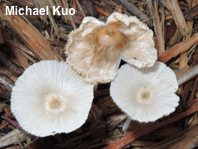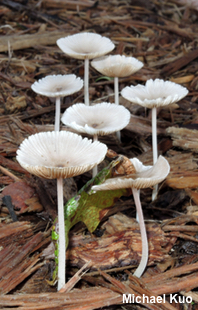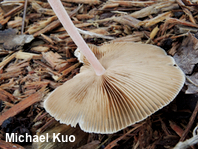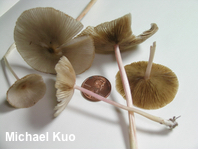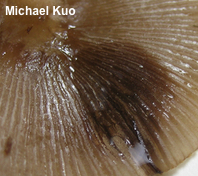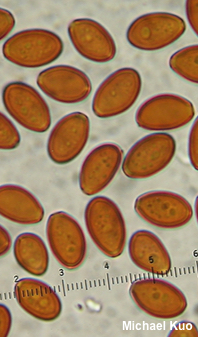| Major Groups > Gilled Mushrooms > Dark-Spored > Bolbitius > Bolbitius coprophilus |

|
[ Basidiomycota > Agaricales > Bolbitiaceae > Bolbitius . . . ] Bolbitius coprophilus by Michael Kuo, 30 October 2023 Although the species epithet, coprophilus, means "dung loving," Bolbitius coprophilus is also found on compost, nitrogen-rich mulch, straw, and woodchips. Young specimens are easily identified by their white-stained-pink, egg-shaped caps, but the caps quickly begin to turn pinkish brown to dull grayish brown—while the stem develops pink shades from the apex downward. Under the microscope, Bolbitius coprophilus features large spores that are flattened on one end for a large pore. Description: Ecology: Saprobic, decomposing dung or nitrogen-rich mulch; usually found in urban settings; growing alone or gregariously; summer and fall (and over winter in warm climates); originally described from New York (Peck 1894); widespread in Europe and in North America. The illustrated and described collection is from Illinois. Cap: 2.5–6 cm; egg-shaped to broadly conic at first, becoming broadly bell-shaped to broadly convex and eventually flat or depressed; whitish to pinkish when young, soon becoming pinkish to pale grayish brown; sticky when fresh; bald; strongly lined, often nearly all the way to the center. Gills: Narrowly attached to the stem; close; short-gills occasional, mostly near the margin; whitish at first, becoming faintly pinkish to brownish, then cinnamon brown. Stem: 4–10 cm long; 2–3 mm thick; equal, with a slightly thickened base; fragile; hollowing; finely pruinose, or more or less bald; white at first, becoming pink from the apex downward; basal mycelium white. Flesh: Insubstantial; pale brownish; unchanging when sliced. Odor: Not distinctive. Chemical Reactions: KOH on cap surface gray. Spore Print: Dull cinnamon brown. Microscopic Features: Spores 11–15 x 7–9 µm; subellipsoid, with one end truncated for a 1.5–2 µm pore; smooth; thick-walled; orange-brown in KOH. Basidia 20–25 x 9–12 µm; abruptly clavate; 4-sterigmate. Brachybasidioles present. Cheilocystidia irregularly cylindric or lageniform; smooth; thin-walled; hyaline in KOH; collapsing. Pleurocystidia not found. Pileipellis hymeniform; terminal cells 25–30 x 7.5–10 µm; clavate; smooth; hyaline in KOH. REFERENCES: (C. H. Peck, 1894) T. Hongo, 1959. (Kauffman, 1918; Smith, Smith & Weber, 1979; Watling, 1982; Hemmes & Desjardin, 2002; Arnolds, 2005; Amandeep et al., 2013; Malysheva et al., 2015; Hausknecht & Vesterholt, 2018; González & Peman, 2019; Læssøe & Petersen, 2019; Usman et al., 2022.) Herb. Kuo 06201502. This site contains no information about the edibility or toxicity of mushrooms. |
© MushroomExpert.Com |
|
Cite this page as: Kuo, M. (2023, October). Bolbitius coprophilus. Retrieved from the MushroomExpert.Com Web site: http://www.mushroomexpert.com/bolbitius_coprophilus.html |
